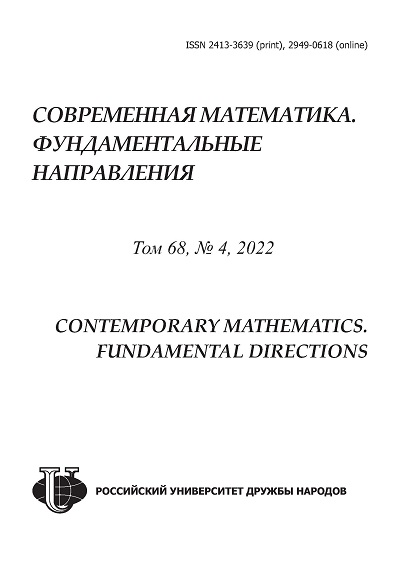Том 68, № 4 (2022)
- Год: 2022
- Статей: 11
- URL: https://journals.rudn.ru/CMFD/issue/view/1620
- DOI: https://doi.org/10.22363/2413-3639-2022-68-4
Весь выпуск
Статьи
Влияние численной диффузии на скорость роста вязких пальцев при численной реализации модели Писмана методом конечных объемов
Аннотация
Рассмотрена численная модель вытеснения нефти смесью воды и полимера на основе модели Писмана. Проведены численные эксперименты с помощью пакета DuMux, представляющего собой программную библиотеку, предназначенную для моделирования нестационарных гидродинамических задач в пористых средах. Пакет программ использует вариант метода конечных объемов «vertex-centered». Исследовано влияние диффузии на скорость роста «вязких пальцев». Получены зависимости скорости переднего фронта от значения модельной диффузии для трех моделей вязкости. Показано, что влияние численной диффузии на скорость роста «вязких пальцев» ставит ограничения на расчеты при малых значениях модельной диффузии.
 553-563
553-563


Сингулярные краевые задачи для квазилинейных уравнений со смешанной реакцией-диффузией
Аннотация
Мы изучаем существование решений задачи
\[\label{A1} \begin{array}{rl} -\Delta u+u^p-M|\nabla u|^q=0 & \text{в }\;\Omega,\\ u=\mu & \text{на }\;\partial\Omega \end{array}\]
в ограниченной области \(\Omega\), где \(p>1\), \(1
\[\label{A2} \begin{array}{rl} -\Delta u+u^p-M|\nabla u|^q=0 & \text{в }\;\Omega,\\ u=0 & \text{на }\;\partial\Omega\setminus\{a\}. \end{array}\]
Трудность заключается в оппозиции двух нелинейных членов, имеющих разную природу. Существование решений задачи [A1] достигается при емкостном условии
\[\mu(K)\leq c\min\left\{cap^{\partial\Omega}_{\frac{2}{p},p'},cap^{\partial\Omega}_{\frac{2-q}{q},q'}\right\}\quad\text{для всех компактов }K\subset\partial\Omega.\]
Задача [A2] зависит от нескольких критических условий на \(p\) и \(q\), а также от соотношения величин \(q\) и \(\dfrac{2p}{p+1}\).
 564-574
564-574


Построение плоских векторных полей с непростой особой точкой заданной топологической структуры
Аннотация
Рассматривается задача построения n-линейных (n 2) плоских векторных полей с изолированной особой точкой и заданными сепаратрисами определенных типов. Такие построения основаны на использовании векторной алгебры, качественной теории динамических систем второго порядка и классических методов исследования их особых точек. Эта задача по существу является обратной задачей качественной теории обыкновенных дифференциальных уравнений, и ее решение может быть использовано для синтеза математических моделей управляемых динамических систем различной физической природы.
 575-595
575-595


Неавтономная динамика: классификация, инварианты, реализация
Аннотация
Работа является кратким обзором результатов, полученных в неавтономной динамике, опираясь на понятие равномерной эквивалентности неавтономных систем. Этот подход к изучению неавтономных систем был предложен в работе [10] и развит далее в работах второго автора, а недавно - совместно обоими авторами. Такой подход видится плодотворным и перспективным, поскольку он позволяет развить неавтономный аналог теории динамических систем для указанных классов систем и дать классификацию некоторых естественных классов неавтономных систем, используя инварианты комбинаторного типа. Мы показываем это для классов неавтономных градиентноподобных векторных полей на замкнутых многообразиях размерности один, два и три. В последнем случае появляется новый инвариант эквивалентности, тип дикого вложения устойчивых и неустойчивых многообразий [14, 17], как было показано в недавней работе авторов [5].
 596-620
596-620


О системе дифференциальных уравнений со случайными параметрами
Аннотация
Получены явные формулы для математического ожидания и вторых моментных функций решения линейной системы обыкновенных дифференциальных уравнений со случайным параметром и векторной случайной правой частью. Задача сводится к детерминированной задаче Коши для систем линейных дифференциальных уравнений в частных производных первого порядка. Получена явная формула решения линейных систем уравнений в частных производных первого порядка с постоянными коэффициентами. Приведен пример, показывающий, что случайные факторы могут оказывать стабилизирующее влияние на линейную систему дифференциальных уравнений.
 621-634
621-634


Модель деформаций струнной системы на графе-звезде с нелинейным условием в узле
Аннотация
В настоящей работе проведено исследование модели деформаций системы стилтьесовских струн, расположенных вдоль геометрического графа-звезды, с нелинейным условием в узле. Такого рода условие возникает за счет наличия в узле ограничителя на перемещение струн под воздействием внешней нагрузки. В работе установлены необходимое и достаточное условия экстремума энергетического функционала; доказаны теоремы существования и единственности решения; проанализированы критические нагрузки, при которых происходит соприкосновение струн с ограничителем; установлена зависимость решения от длины ограничителя.
 635-652
635-652


Явное решение задачи Дирихле в невыпуклом угле
Аннотация
В этой работе мы даем явное решение краевой задачи Дирихле для уравнения Гельмгольца в невыпуклом угле с периодическими граничными данными. Мы представляем теоремы единственности и существования в соответствующем функциональном классе и даем явную формулу решения в виде интеграла Зоммерфельда. Используется метод комплексных характеристик [14].
 653-670
653-670


Усреднение параболического уравнения в перфорированной области с односторонним динамическим граничным условием: критический случай
Аннотация
В настоящей работе изучается усреднение параболического уравнения, заданного в области, перфорированной «крошечными» шариками. На границе этих перфораций заданы односторонние динамические граничные ограничения. Мы обращаемся к так называемому «критическому» случаю, который характеризуется связью между коэффициентом в граничном условии, периодом структуры и размером отверстий. В этом случае усредненное уравнение содержит нелокальный «странный» член. Этот член получается как решение вариационной задачи, содержащей обыкновенный дифференциальный оператор.
 671-685
671-685


Численный анализ стационарных решений систем с запаздывающим аргументом в математической иммунологии
Аннотация
Данная работа посвящена разработанной авторами технологии вычисления при фиксированных значениях параметров и трассирования по параметрам стационарных решений систем с запаздыванием и анализа их устойчивости. Обсуждаются результаты применения этой технологии к модели противовирусного иммунного ответа Марчука-Петрова со значениями параметров, соответствующими инфекции гепатита В. Впервые показано наличие свойств бистабильности и гистерезиса в данной модели.
 686-703
686-703


Комплексный росток Маслова и квазиклассические сжатые состояния в задаче Коши для уравнения Шредингера с дельта-потенциалом
Аннотация
Описана квазиклассическая асимптотика решения задачи Коши для уравнения Шредингера с дельта-потенциалом, локализованным на поверхности коразмерности 1. Оператор Шредингера с дельта-потенциалом определяется при помощи теории расширений и задается краевыми условиями на этой поверхности. Начальные данные выбираются в виде узкого пика, представляющего собой гауссов пакет, локализованный в малой окрестности точки. Для построения асимптотики используется метод комплексного ростка Маслова. Описывается отражение комплексного ростка от носителя дельта-потенциала.
 704-715
704-715


Существование решения задачи со свободной границей для систем «реакция-диффузия»
Аннотация
В работе доказывается существование решения новой задачи со свободной границей для систем типа «реакция-диффузия», описывающих рост биологических тканей вследствие притока клеток и пролиферации. Для этого задача сводится к задаче с закрепленной границей через замену переменных. Полученная задача имеет зависящие от времени и положения в пространстве коэффициенты с нелинейными слагаемыми. Затем мы доказываем существование решения для соответствующей линейной задачи и с помощью теоремы о неподвижной точке получаем существование решения нелинейной задачи. Наконец, мы возвращаемся к задаче со свободной границей и делаем вывод о существовании ее решения.
 716-731
716-731












